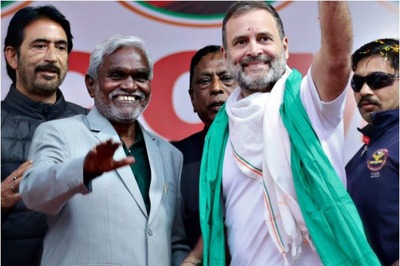
views
Bitcoin’s price tumbled last month following the news that regulators in China would ban domestic banks from dealing in cryptocurrencies. Chinese banks will not process payments made in cryptocurrencies or allow bank customers to hold bitcoin in their accounts. It also stopped Chinese banks from converting bitcoin into yuan or any other type of currency. India, too, has been mulling over the ban on cryptocurrencies’ operations in the country and it was announced that a bill would be passed in Parliament to outlaw cryptocurrencies in the country, except for the digital rupee one that is backed by the Indian government, similar to what China is attempting with the digital yuan. China’s latest move is another iteration of its crackdown on cryptocurrencies. In 2017, it outlawed the operation of Initial Coin Offerings (ICOs), the cryptocurrency analog for an Initial Public Offering (IPO) for stocks.
Digital currencies and cryptocurrencies are a thorny issue for nations and regulators. After all, if cryptocurrencies are allowed to proliferate and be used as a substitute for a nation’s currency, it can potentially infringe on the sovereignty of the country as central banks lose control over production and supply of coinage. In response, China, India along with several countries’ central banks have floated ideas for a Central Bank Digital Currency (CBDC), a digital representation of a nation’s currency backed by blockchain technology. Whether this is by design or accident, Beijing has been influencing policies of other nations when it comes to cryptocurrencies, and, consequently, how cross-border payments work. China and Chinese companies’ decisions on digital payments companies can be seen as a form of tech diplomacy.
CBDCs are a new and untested idea and though it holds a lot of promise for different countries, its implementation and actual use cases are yet to be fully developed. China has begun piloting its CBDC, but in the larger geopolitical landscape, it represents a threat to the United States dollar as the world’s dominant currency. If the usage of the digital yuan increases with countries, it could undermine Washington DC’s efforts to uphold international sanctions by prohibiting transactions using the US dollar. Currently, the United States wields an enormous influence on the Society for Worldwide Interbank Financial Telecommunication (SWIFT) messaging system, which is used by banks and financial institutions to send money transfer instructions. The digital yuan, using blockchain technology, can bypass these restrictions.
Against this backdrop, there is an opportunity for India to wield some influence over tech diplomacy with digital payments.
Chandni Chowk to China
Though China is now a strategic rival to India, New Delhi and Mumbai are tempted to follow in their footsteps by enacting a similar ban on cryptocurrencies. However, the 2020 Galwan clashes have disturbed India-China relations. Chinese capital and technology ideas have influenced India’s domestic payments ecosystem. The most notable is Paytm, where Ant Financial has a 30 per cent stake in the company. Paytm along with other digital wallets in the country helped popularise the idea of QR code payments in the country. Paytm CEO, Vijay Shekhar Sharma, said that the company was inspired by how Jack Ma’s Alipay used QR code payments to dominate payments in the country.
Following the incursion in the Galwan valley, Chinese diplomatic and economic relations with India have turned frosty. The Indian tech startup ecosystem, which had relied on Chinese capital for their growth expansion, suddenly had to change gears and distance themselves from China. The most notable example was when restaurant aggregator and food delivery service Zomato wasn’t able to raise US $100 million from Ant Financial in 2020, following a change in foreign direct investment (FDI) rules. In April 2020, India put curbs on FDI from countries that share a land border with it, a move that has angered China. India tightened FDI regulations to “prevent opportunistic takeovers or acquisitions of Indian companies during COVID-19 pandemic.”
The seeds of this could be seen earlier in the payments space as well. In 2018, the Committee on Foreign Investment in the United States (CFIUS) scuttled a US $1.8 billion merger between Ant Financial and international remittance company MoneyGram citing national security concerns. At the time, India’s Paytm was supposed to play a strategic role if the deal had gone through and would have helped Ant Financial expand its footprint across Southeast Asia and India to about 630 million users—450 million of Alipay’s users and 180 million users from Paytm.
Paytm’s fortunes since have turned for the worse with the introduction of the Unified Payments Interface (UPI), a domestic interbank account-to-account payments architecture that allows funds transfer through virtual aliases without cost. This killed a key feature of Paytm’s mobile wallet use case where people could transfer money from wallet-to-wallet without cost. Soon, other contenders like Walmart-owned PhonePe and Google Pay overtook Paytm’s position in terms of users and number of transactions. Though, it must be pointed out that the UPI has seen great success and the overall number of transactions now stand in excess of 2.5 billion per month, primarily driven by the rivalry between PhonePe, Google Pay and Paytm.
The Indian Opportunity
The National Payments Corporation of India (NPCI), which owns the UPI architecture, is a unique entity in the Indian technology landscape. It is a not-for-profit organisation which has a monopoly over the retail payments services in the country. In addition to the UPI, it also runs a bill payments architecture, handles the toll payment systems, operates an ATM network, a cheque clearing house, and another real-time payments system called IMPS.
The NPCI is not a government entity but is promoted by members of the Indian Banks Association, the banking lobby organisation and has the blessings of the banking regulator, the Reserve Bank of India (RBI) and the finance ministry. In some sense, the NPCI acts as a quasi-regulator for retail payments in the country where member banks must comply with its rules and regulations or face punitive action. However, the success of the UPI in India has prompted the NPCI to set up a company called NPCI International Payments Limited (NIPL) with the sole purpose of exporting the UPI architecture.
The NPCI’s move can be seen as a form of exercising soft power. Indeed, seeing the success of Google Pay in India using the UPI architecture, the company wrote to the United States Federal Reserve supporting a similar interbank real-time payments architecture called FedNow in the country. FedNow currently has five regional California banks and three credit unions testing out the service. In Europe, BNP Paribas is leading similar account-to-account fund transfer experiments.
Potentially, India, through NIPL, could lead this form of tech diplomacy for setting up an interoperable payments network for various regions. Germany has had some misgivings about the SWIFT network and has called for an end of US dominance over international payments and adopting its own international payments channel for the European Union.
The NPCI may not find it easy to build a rival network of banks and financial institutions to SWIFT. To begin with, SWIFT has more than 11,000 members across the globe. In contrast, the UPI architecture has a mix of 220 banks of various sizes and technical capabilities.
The UPI’s architecture might not be best suited for other geographies’ needs and may not fit in with their business and political landscapes. The US Federal Reserve is facing criticism from banks for operating a competing payments system with private companies while acting as their regulator, a conflict of interest that RBI is comfortable with operating the Real-Time Gross Settlement systems. This is significant because though the UPI says that it processes transactions instantly, the amounts are settled with different banks at a later time. Further, banks in the United States are loathe to give up their fees on inter-bank transactions.
The architecture of the UPI also places a lot of emphasis on interoperability of payments. This is a feature that banks in other geographies might not be comfortable with. Essentially, the UPI unbundles payments from the bank and the bank account. It enables interoperability by using open banking APIs to allow bank A to access account information from bank B and initiate a payment. This was done in India to bring more competitiveness in India’s bank payments landscape where customers could pick bank applications with better user experience to access funds from their account. Essentially, with this model, a rival bank can get payments data of existing account holders and offer other services.
None of this would be possible without patronage from the government and the regulator. In fact, in the aftermath of the 2016 demonetisation exercise when old notes were being exchanged, UPI applications were widely promoted by Prime Minister Narendra Modi in India to enable cashless transactions.
It would be extremely difficult to replicate the political and business will for the setting up of UPI in different geographies. But ultimately, diplomacy boils down to the adoption of new ideas without arousing hostility. For example, though Jack Ma’s Ant Financial’s fortunes have taken a huge setback following Chinese regulators’ crackdown on his internet conglomerate, the idea of using QR codes for payments has been co-opted by the UPI in India. Similarly, the idea of account-to-account real-time transactions is gaining ground in the United States and Europe. Herein, lies the opportunity for India.
This article was first published on ORF.
Read all the Latest News, Breaking News and Coronavirus News here.




















Comments
0 comment